 BUY IT AT AMAZON:
BUY IT AT AMAZON:
CLICK HERE!
STUDIO:
Metro-Goldwyn-Mayer
MSRP: $26.98
RATED: R
RUNNING TIME: 3
hours 26 mins.
SPECIAL FEATURES:
• Audio
commentary with Lady Sandra Lean, Actress Sarah Miles, Petrine Day Mitchum
(Robert Mitchum’s daughter), Assistant Director Michael Stevenson, Second Unit
Director Roy Stevens, Art Director Roy Walker, Assistant Editor Tony Lawson,
Location Manager Eddie Fowlie, Stuntman Vic Armstrong, Lean Biographer Steven
M. Silverman, Director John Boorman, Director Hugh Hudson, and
Director/Critic/Historian Richard Schickel
• The
Making-of Ryan’s Daughter: A 3-Part 35th Anniversary Documentary (with Ryan’s
Daughter: Storm Rising, Ryan’s
Daughter: Storm Chasers, and Ryan’s
Daughter: The Eye of the Storm)
• 2
Vintage Documentaries (We’re the last of
the Traveling Circuses and Ryan’s Daughter: A Story of Love)
• 2
Theatrical Trailers (The Announcement Trailer and Theatrical Trailer)
There’s an infamous story in Kevin Brownlow’s biography on David Lean (buy it here) involving the filmmaker and the National Society of Film Critics. The group, which consisted of several heavyweights, such as famed critic Pauline Kael and workaholic Society Chair Richard Schickel, conceived this idea of having a variety of directors to come to off-the-record informal give-and-take ‘dialogues’ – the goal being to put a human face on each artists side of the process; filmmaker and critic. Lean’s first encounter started out rather well, especially when Schickel allegedly commented – “can you please explain how the man who directed Brief Encounter can have directed this load of shit you call Ryan’s Daughter?” before the group laid into Lean with reckless abandon. As it progressed into insanity, Lean commented to Kael that she wouldn’t be “content until you’ve reduced me to making a film in black and white on 16mm.”
Kael promptly responded: “we’ll give you color.”

"I’ll teach that Peter Weller a thing or two about Screamers!"
Lean would become so downtrodden that he wouldn’t make another feature length film – he did make a documentary about the search for Captain Bligh’s Anchor in his failed attempt to make The Bounty into two films – until 1984’s Passage to India.
The Flick
Ryan’s Daughter is often regarded as David Lean’s folly. Made for an exorbitant amount even in the late sixties (local British filmmakers griped loudly that it could have financed three of their films), Lean’s visceral film is nothing short of an epic event interspersed with wobbly notions and some incredibly painterly imagery. What pains me the most is to watch this lumbering behemoth of a creation stagger towards its adventurous Jarre-infused Exit Score, especially after being bewitched by his previous creations – masterpieces like Lawrence of Arabia, Doctor Zhivago, and Bridge on the River Kwai. And although I completely understand that most of his critics bemoaned his former pictures with a touch of nostalgia for the latter, Ryan’s Daughter is one of those cases where the parts don’t quite add up to the sum of the entire experience. Even gifted filmmakers strike out once and a while (Hook, Van Sant’s Psycho, and Crimewave come to mind), so allow me to frown as it is with a heavy heart I look at one of my idol’s filmographies with a kink in its armor.
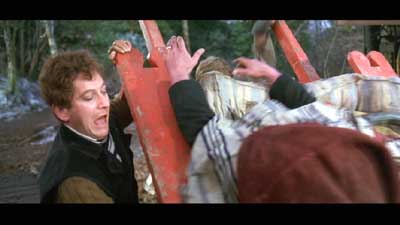
"Raise your hands if you’re dead!"
I spent countless numbers of hours growing up watching old panned & scanned VHS copies of Lean’s films – yes, that includes the bastardly chopped Lawrence (a film that has hopefully been outright banned from seeing it on nothing less than a theatre’s large screen) and the film we’re here to discuss today. If my local video store was unable to secure such a copy, I’d travel far and wide (usually 40 minutes or so to my video store of choice – Cinema 93) to keep my undying quest to voraciously study his films because their emotional and visual impact was nothing short of a heavy-handed punch right to the gut. His vision is unparalleled; his work the same. He is simply one of the greatest directors of all time.
I get tremendously giddy when a wide vista is tracked alongside actors interacting with the breadth and scope of their filmed environment. But in Lean’s films, such wasn’t always the case. He had accomplished films on a much smaller scale with successful results (try telling me that Great Expectations isn’t one of the premiere adaptations of the novel, let’s argue that the opening to Oliver Twist isn’t atmospheric and emotionally resonant; in fact is The Passionate Friends a worthwhile romantic endeavor? I’d say so, especially with Claude Rains feeling incredibly lovelorn). But with Ryan’s Daughter, Lean seems to have gotten a case of trying to shoot a three pointer when all is needed is a foul shot from behind the line. Sports metaphors were never my bag.

"I’d wish you good luck, but I already tapped that last week."
Lean’s white-hot intensity is blown up in Ryan’s Daughter, which essentially should have been a much quieter story set against a more reigned-in backdrop of World War I Ireland. The story starts out with Rosy Ryan (Sarah Miles) playing a fool to her wanderlust instincts, roving about the countryside with nothing better to do with her time. This will ultimately inform the rest of her story, as she’s caught up in a Walker Percy-esque search for the elusive. Not only does she not quite understand what she wants, but she knows that when she finds it, it’ll make her feel complete in a topsy-turvy world. Part of her search involves the mystical impure thoughts of being intimate with others. She confides with the town’s headstrong Priest Father Collins (the belligerently spectacular Trevor Howard) that she wishes that the satisfaction of the flesh would make her a different person.
Rosy doesn’t really understand what more there is, that is, until she’s smitten with local Schoolteacher Charles Shaughnessy (Robert Mitchum). The pair quickly become married, but life doesn’t become more vivacious; rather more complacent, more conservative in its fun. So naturally things get shaken (being the watchword) up furiously when Major Randolph Doryan (the woefully miscast Christopher Jones) arrives, fresh from being battle-scarred on the pockmarked fields of the European front. Rosy and Doryan are quick to fall in love, and even quicker to disregard the consequences of what their illicit pairing means to the town, to themselves, and to the mind of Charles Shaughnessy.
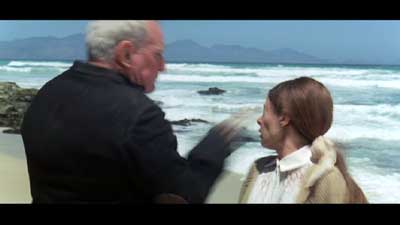
Never wish for a sequel to C.H.O.M.P.S. while around a Man of God.
While Rosy’s search might have become fruitful, the rest of the narrative developments are scattered through the B-stories of IRA involvement (one of its operatives is played by the great Barry Foster) against the British occupation in their native land, alongside the childlike curiosity of the town’s invalid Michael (played by John Mills); a man who seemingly stumbles abound discovering everything from an incredibly advantageous point of view.
Lean’s signature style suffers no loss of life throughout the film. The widescreen Panavision vistas are prevalent throughout each and every sequence; some of the scenes, including those where Rosy and Doryan go off in the forest to consummate their love, are nothing short of visually breathtaking – Lean paints in his stylistically vivid brushstrokes favoring his expanse of scope. His directorial prowess is in full command, and as a viewer you are powerless to not be swept up in its poetry of the man who laid siege to far horizons. Coincidentally, one of my favorite scenes from his uneven film is that of Mitchum’s dream sequence of Rosy and Doryan’s walk around the beach, and Lean’s camerawork and master-craftsman abilities do not disappoint. This is his natural progression as an artist after creating some memorable moments in cinematic history.

He was so emo his tears ran red.
As such, it would be foolish of me to not point out Freddie Young’s sumptuous cinematography (he also shot Lawrence and Zhivago). As the film progresses it becomes this hazy lovelorn ode to brushing off all those around you, and Young’s visuals compliment those instincts insanely well. In terms of gorgeousness, you could do far worse than keeping up with Young’s usage of shading and light – prevalent in the shots leading up and during the relatively harmless, yet magnificently stunning sex scene. Thankfully, he was rewarded justly.
Upon first glance, famed screenwriter Robert Bolt’s screenplay appears incredibly nuanced – calling for a more deft touch in handling the seemingly intimate encounters scattered throughout its plot. A simpler, closer focus would have benefited Bolt’s developments more thoroughly than Lean’s sweeping choice of presenting the material. This is probably why Lean’s sensibilities appear to have clashed with the film as a whole. In particular, there’s a sense of a film attempting to burst outright and explode all over the screen. And while it works in some instances; in others, like the unnecessarily lengthy last hour (of the film’s 3 hour, 26 minute runtime), were where I found myself wishing the film’s denouement was shortened to accommodate the stretched narrative points to unfathomable lengths. These instances are certainly not boring though, but rather take their time to play out. One might argue that at this point in time, Lean was expected to present such events with as much time as possible. However, it just feels like too little spread out to form too much for this more modern viewer.

"Sorry I had to unload 32 years of pent-up aggression,
but you said you loved Captain Kirk too!"
Maurice Jarre’s score feels a touch too emotional in many areas. Its juxtaposition amongst several sequences involving a different set of aural strings (specifically towards the end when Rosy and Michael share a telling moment) almost transcend into head-scratching levels of unbelief. Jarre’s lush mixture of Zhivago-esque romance is prevalent throughout the entire film and his theme is quite haunting, much like that of his previous Lean collaborations. But still, in Ryan’s Daughter, there’s that weird coupling between image and sound that’s strangely odd more than a few times. Meanwhile, working diligently with Production Designer Stephen B. Grimes (Lean’s regular collaborator John Box was off producing other films at the time), Lean creates a very authentic portrait of life within Ireland’s minimalist society during the uneven World War One era. Sets feel lived-in, and the film’s town, built whole from scratch, serves as a wonderful testament to those falling under the film’s skewed hypnotic spell.
As for the players in the film, one sour note is the portrayal of Michael, by John Mills. I feel he hurts the film tremendously, and really serves as a catalyst for the more important matters, such as him acting as the pseudo-know-it-all for the film, even though he utters nary a word. Mills’ inhabitance in the role feels all entirely too wrong. He tends to drag down scenes with his effortlessly drooling mouth-opened presence, and in others, where he discovers a plot point or two (or three in some cases), I felt like he had regressed to become a relatively unnecessary sleuth and informer in order for audiences to connect the dots. I understand that he’s needed for his one pivotal scene where his pantomiming informs pretty much the whole town into a frothing frenzy, but I just can’t bear to watching him waste precious time in dragging out the rest of the story.

"Kids … never marry. So endeth the lesson."
The anchor of the film, Robert Mitchum, is oddly cast against his regular tough guy persona in the role of a relatively restrained (maleness-wise) and somewhat boring Schoolmarm. His hum-drum drab existence partially informs who he is, although this character is something Mitchum approaches with relative ease, bringing a reserved intensity towards Shaughnessy’s patience in the face of a crumbling marriage. It’s when Rosy’s father comments that he’s a just man, a fair man, one really starts to hit home on all the previous scenes. The result is not necessarily his greatest creation, but he does bring history and gravitas into the proceedings.
Sarah Miles’ Rosy is a fairly good example of what works well about Lean’s careful consideration into picking people who’ll inhabit the roles he tinkered away on. Miles, the wife of the late Robert Bolt, does bring a balanced thoughtfulness to her conflicted desires. There’s a scene where she’s relatively aghast she’d allow herself to jump into a tempestuous relationship with a British Solider, but nonetheless Miles’ charms as a beauty and a seemingly good thespian aren’t one of the nagging qualities about the rest of the film.

"Do me a favour?"
"Of course."
"Get your hands off of ye olde cock!"
Christopher Jones, on the other hand, is one of those troublesome items which weigh the film down. He’s a spot-on look-alike for James Dean, but without any of that actor’s unique qualities of not fitting in one’s own skin. Jones’ quiet, reserved nature throughout the plot resembles more of David Lean’s desire to keep his mildly passable performance under the radar. I’ve heard Marlon Brando was offered the part many times (Lean wanted desperately to work with him, alas it never happened), and one can imagine the sort of commanding presence Brando would have infused into Major Doryan. Jones is quite mediocre.
The rest of the cast fits rather well, considering they’re also parts on a buoy that helps keep the film partially afloat. Trevor Howard’s Father Collins is a bright note in the film. He’s always reminded me what could have happened if a Dead End kid grew up and moved to Ireland and became mature towards the ways of the world. Howard’s staunch authoritarianism is a crutch for most of the scenes, but I’ll be damned if he isn’t merely enjoyable to watch. Additionally, Barry Foster’s IRA Agent of doom utters one of my favorite lines in cinematic history – “talk? This whole cursed country will capsize in talk” – and ultimately he stands as the singular voice of anti-British sentiment throughout the film, promptly telling them to f-off in the process. As for the rest of the cast – populated by various other unknown actors to today’s generation – their cantankerous Irish ways fit the bill but don’t blow any of those Central Casting impresarios out of the water.
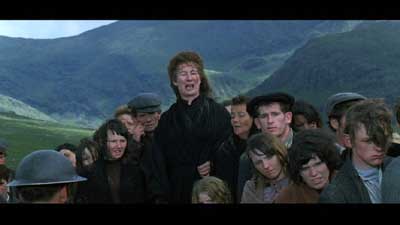
"Any takers? — I have soooo much love to give!"
As it stands, Ryan’s Daughter is an interesting mixture. It’s not quite a complete disappointment, but it’s not quite like those previous David Lean films generations of filmic scholars have come to drop down on one knee while praising.
8.2 out of 10
The Look
Warner Brothers have done fantastic work with Lean’s imagery. For such a respected filmmaker, I’d expect nothing less. They do not let anybody down with their transfer, which might be one of the better one’s I’ve seen – ever. Presented in the 70mm film’s 2.21:1 aspect ratio, the colors are crisp and well-balanced; faces appear natural and realistic, the widescreen vistas almost jump out at you and surround your environment. If you don’t wish to visit Ireland after watching this film – one of the side effects of watching any David Lean film, then you’re a gigantic pansy.
9.5 out of 10
The Noise
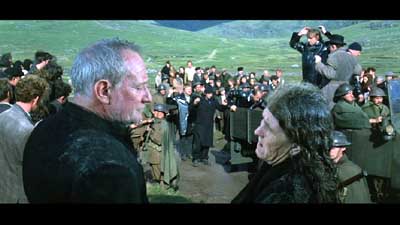
"Father, you know the book has helped me in these times…"
"Well, blessed be…"
"No. I meant the Necronomicon."
The film’s original mono score has been remixed for Dolby Digital 5.1. Most of the sounds have been front-loaded, though, and you’ll see a respectable amount of crowd noises, storm effects, and Jarre’s score come bursting out of your back speakers. This mix is rather adequate for a film that’s over 35 years old. While we were never going to get a fully immersible experience aurally, I’m damn happy with what those audio geniuses at WB’s Post department have cooked up.
8.5 out of 10
The Goodies
Oddly enough, for such a critically reviled film, it’s rather like Richard Pryor – bustin’ out.

Frowny McAngerson was certainly in a good mood.
First up is a crowded audio commentary track with Lady Sandra Lean, Actress Sarah Miles, Petrine Day Mitchum (Robert Mitchum’s daughter), Assistant Director Michael Stevenson, Second Unit Director Roy Stevens, Art Director Roy Walker, Assistant Editor Tony Lawson, Location Manager Eddie Fowlie, Stuntman Vic Armstrong, Lean Biographer Steven M. Silverman, Director John Boorman, Director Hugh Hudson, and Director/Critic/Historian Richard Schickel. In short, it’s almost too packed. There’s a hell of a lot of voices to be introduced and kept track of, and DVD producer Laurent Bouzereau introduces most of them by name beforehand. It does get a little overwhelming at times, but the sheer wealth of material presented by all those who knew Lean and Mitchum is well worth the time of anyone interested in the making of the film and the escapades that happened. Some great moments involve the Storm sequence (with famed Stuntman Armstrong talking about what they used to combat its effects primitively – i.e. fisherman’s coats) and the fact that Lean and Mitchum didn’t see eye-to-eye on a number of occasions. It’s a good listen, if a lengthy one.
There’s two theatrical trailers – the announcement trailer (runtime: 2:20) which is more notable for the production shots of Lean working towards shooting the film. The theatrical trailer (runtime: 2:55) bases more of its information on Lean’s previous films, comparing Ryan’s Daughter to Kwai, Lawrence, and Zhivago, culminating by saying “like any other film by David Lean it is a masterpiece.” Um, they might wish to recheck that statement.

Take THAT – Klaxons!
Next up is the Making-of Ryan’s Daughter which is split up into three parts – Ryan’s Daughter: Storm Rising, Ryan’s Daughter: Storm Chaser, and Ryan’s Daughter: The Eye of the Storm. The nitty-gritty is presented quite spectacularly here. David Lean is front-and-center with a variety of information that is almost a breath of fresh air from today’s pooh-poohing featurettes we’re subjected to (and they’re getting tired and played, fool). Still, if you’ve listened to the audio commentary track beforehand, some of the information is recycled at rather large lengths. That’s a shame. There are some good bits, though, and scattered throughout is information on the film’s ballooning shoot (from 4 weeks to 52) and a good discussion on the windscreen for the camera lens, using centrifugal force to expel water off it during the film’s famous windstorm. I just wish that the cast and crew didn’t revere the whole entire film as much as they ultimately do. Some more disconnected perspective (other than Richard Schickel retelling the meeting story) would have been a great counterpoint.
Finally, there are 2 vintage documentaries. The first is We’re the last of the Traveling Circuses (runtime: 20:00) which is priceless. Most of the footage here was, again, recycled for the above documentary, but in it are spectacular bits of Robert Mitchum and his gallows humor. He’s hilarious – and even mentions he did the film only because Robert Bolt promised to pay for his funeral expenses. The interview with John Mills is particularly stunning, if only because he’s so casual. The actors and David Lean are tremendously forthcoming and refreshingly candid for the BBC production. On a side note, everybody and their uncle smokes in this documentary. A lot of them died from its side affects later on.
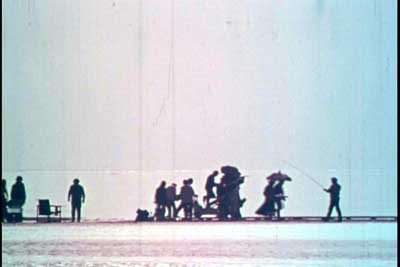
Loverly.
The second is Ryan’s Daughter: A Story of Love (runtime: 6:13), which is essentially the Announcement trailer beefed up to epic levels. You’ll get another synopsis of story, and that oft-used masterpiece line.
Overall? While some of its information is rehashed, it’s not bad.
9.0 out of 10
The Artwork
 Adequate. It’s a flipped composite from the film’s 1980 rerelease. That said, I’d have preferred the original 1970 iconic image of Rosy with her umbrella walking alongside the beach, but it doesn’t sell the film’s stars all that much. I’m not particularly fond of the imagery as is, considering the cartoonish nature of the humans feels stifled by what could have been something extraordinary. Then again, I’m also biased towards all Lean films, so I suppose that’s that. That fact that a lot of Lean films are now available on DVD (Sony? Where’s our David Lean Collection? – soon?) makes me happier than a Bear raping a Yellowstone Employee.
Adequate. It’s a flipped composite from the film’s 1980 rerelease. That said, I’d have preferred the original 1970 iconic image of Rosy with her umbrella walking alongside the beach, but it doesn’t sell the film’s stars all that much. I’m not particularly fond of the imagery as is, considering the cartoonish nature of the humans feels stifled by what could have been something extraordinary. Then again, I’m also biased towards all Lean films, so I suppose that’s that. That fact that a lot of Lean films are now available on DVD (Sony? Where’s our David Lean Collection? – soon?) makes me happier than a Bear raping a Yellowstone Employee.
7.5 out of 10